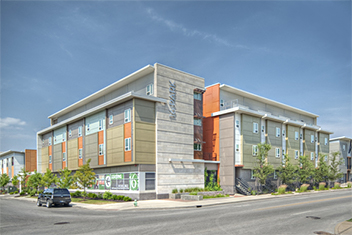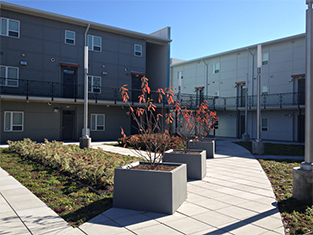
Sustainable Housing in Indy’s Smart Growth District

The 16 Park Apartments are supporting the revitalization efforts in Indianapolis’s Smart Growth Redevelopment District. Image courtesy of Insight Development.
The Near Northside of Indianapolis is home to a new green, affordable housing development. Combining sustainable site design and energy efficiency, 16 Park Apartments (16 Park) is a comprehensive redevelopment of the aging Caravelle Commons affordable housing complex. Completed in June 2013 by Insight Development, the nonprofit development arm of the Indianapolis Housing Agency, 16 Park significantly improves the quality of housing available to low-income households in Indianapolis and contributes to longstanding efforts to revitalize one of the city’s main corridors — 16th Street — as a mixed-use, pedestrian-friendly urban district.
Green Infill Development
With 16 Park, Insight sought to improve the social and physical conditions of Caravelle Commons while also supporting the sustainable infill development goals of the 16th Street Strategic Redevelopment Plan. The project’s 155 new apartments increase the site’s housing density from 12 to 30 units per acre. The new project supports a more economically diverse mix of residents: 28 units affordable to households earning less than 30 percent of the area median income (AMI), 35 units affordable to households earning less than 40 percent of AMI, 46 units affordable to those earning up to 50 percent of AMI, and 46 units affordable to those earning up to 60 percent of AMI. With the 63 units in the two lowest affordability ranges set aside for tenants of Caravelle Commons, Insight took steps during redevelopment to prevent displacement. The project was divided into three phases; as new buildings were completed, residents moved from the old units, which were then demolished, to their new homes.
To further the goals of neighborhood connectivity and walkability, the redevelopment includes new roads and improved circulation linking the property to nearby parks, a community center, and other neighborhood assets. Buildings sit close to the street, defining pedestrian walkways and opening sight lines through the neighborhood.
The one- to four-bedroom units offer a spacious living area with upgrades that promote environmental and economic sustainability. High-efficiency furnaces, tankless water heaters, and energy-efficient appliances promote conservation and lower utility bills. According to Insight Development’s president, Bruce Baird, 16 Park is one of the organization’s most ambitious sustainable projects. The project includes significant investments in green infrastructure, with bioswales, rain gardens, and permeable pavers to control onsite stormwater runoff. To further reduce the number of impervious surfaces, three parking structures have green roofs that also provide residents with onsite open space.
Smart Growth in a Smart Location
By expanding housing opportunities and incorporating site improvements that enhance neighborhood connectivity, 16 Park embodies development principles of the city’s Smart Growth Redevelopment District. Encompassing the 16th Street corridor and the 16 Park site, the district was created in 2008 to guide context-sensitive infill development in an area where approximately one-third of properties were vacant. Because of the numerous contaminated properties in the area, the U.S. Environmental Protection Agency designated the redevelopment district a Brownfield Pilot project in 2010 as part of a Partnership for Sustainable Communities initiative.

The single-story parking structures include green roofs that provide open space for residents and stormwater management. Image courtesy of Insight Development.
The overarching goal of the Partnership’s effort is to create neighborhoods that could one day support substantial transit investments through more closely aligned land use and transportation policies. With a 2010 Community Challenge grant, HUD is supporting these efforts in the district, as well as broader efforts in the city and county. One of those efforts is Indy Rezone, the city’s comprehensive effort to prepare development regulations that foster sustainable land use decisions.
16 Park exemplifies Indianapolis’s efforts to guide public and private investment in a previously disinvested part of the city that can now support significant future growth. The $34 million development was financed primarily with equity generated from the sale of low-income housing tax credits ($21 million) and money made available through the American Recovery and Reinvestment Act of 2009 (including $7.8 million in tax credit exchange funds and $4.5 million in public housing capital funds). With a walkability score of 85 (out of a possible 100), the apartments provide housing opportunities in a smart location with access to public transportation, parks, grocery stores, schools, and other community resources.
The Indianapolis Chamber of Commerce recently honored 16 Park with its Monumental Award for Neighborhood Revitalization. The award honors investments that “provide broad benefits to the community and serve as models for future development in central Indiana." As a successful example of infill housing for the region, the project reflects the Partnership for Sustainable Communities’ commitment to federal housing investments that support sustainability.
PD&R Leadership Message Archive
International & Philanthropic Spotlight Archive
Spotlight on PD&R Data Archive
Publications
Collecting, Analyzing, and Publicizing Data on Housing Turnover
Resilience Planning: What Communities Can Do to Keep Hazards from Turning into Disasters
Cityscape: Volume 26, Number 3
Case Studies
Case Study: Former School in Charleston, South Carolina, Transformed into Affordable Housing for Seniors
Case Study: Avalon Villas Combines Affordable Housing and Services for Families in a Gentrifying Phoenix Neighborhood

The contents of this article are the views of the author(s) and do not necessarily reflect the views or policies of the U.S. Department of Housing and Urban Development or the U.S. Government.
Note: Guidance documents, except when based on statutory or regulatory authority or law, do not have the force and effect of law and are not meant to bind the public in any way. Guidance documents are intended only to provide clarity to the public regarding existing requirements under the law or agency policies.



